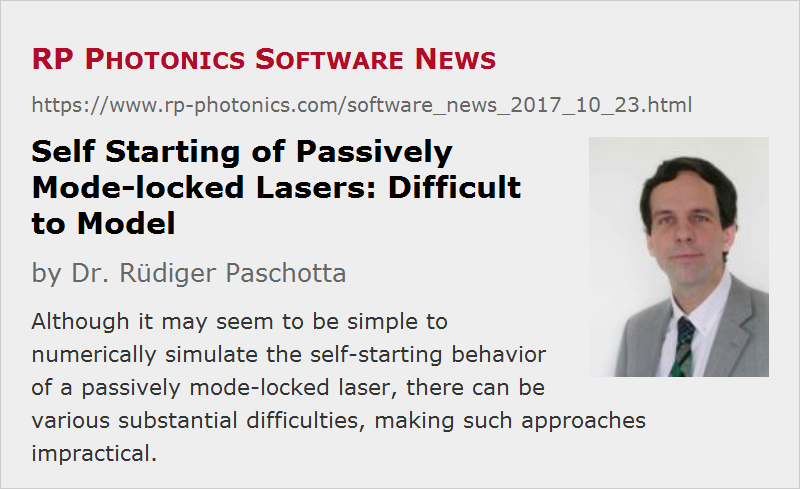Self Starting of Passively Mode-locked Lasers: Difficult to Model
Posted on 2017-10-23 in the RP Photonics Software News (available as e-mail newsletter!)
Permanent link: https://www.rp-photonics.com/software_news_2017_10_23.html
Author: Dr. Rüdiger Paschotta, RP Photonics Consulting GmbH
Abstract: Although it may seem to be simple to numerically simulate the self-starting behavior of a passively mode-locked laser, there can be various substantial difficulties, making such approaches impractical.

Sometimes, I am asked whether our software would be suitable for modeling the self starting of passively mode-locked lasers. It might be useful to discuss that case, since it illustrates some of the typical limitations of numerical modeling.
In principle, it would seem relatively simple to model such a thing e.g. with our software RP Fiber Power or RP ProPulse. The basis is of course a model where one can simulate all the interactions which light experiences in the laser resonator. The initial field configuration would simply be some random noise, which in practice comes from spontaneous emission of the laser medium and could easily be included in our software. Then just simulate some sufficiently large number of round trips, and you will see what you get.
Unfortunately, there are some potentially nasty problems, to be discussed in the following:
Size of the Numerical Traces
In many cases, the round-trip time of light in a mode-locked laser is many orders of magnitude larger than the steady-state pulse duration: a typical pulse repetition rate is 100 MHz, corresponding to 10 ns round-trip time, while pulse durations are often far below 1 ps. When investigating the starting behavior, one would naturally use a numerical trace which is (in the time domain) just long enough to resemble a complete round trip. At the same time, its temporal resolution should be sufficient for the steady-state pulse. Unfortunately, that would lead to huge numerical traces and correspondingly long computation times, and possibly also to problems of limited computer memory. Well, one may consider to use substantially shorter numerical traces, but it is not easy to see whether that would still be realistic.
At least, that problem would be absent in high repetition rate lasers or those where the pulse duration is relatively long.
Parasitic Reflections
The self starting behavior of mode-locked lasers is often influenced by parasitic reflections occurring within the laser resonator or outside the resonator. Perhaps surprisingly, lasers are often extremely sensitive to such parasitic effects; even power reflectivities of the order of 10−8 may be sufficient to cause trouble. There are in principle ways to put them into numerical models, but it would often be extremely difficult to quantify such reflections in real lasers. For example, reflections may result from random scattering on surfaces or in transparent media (particularly in fibers), and in most cases it is even difficult to obtain statistical information on those effects. So even if you have a suitable model, you will hardly find reliable input data for it.
Inhomogeneous Gain Saturation
The details of self starting may also be substantially influenced by the characteristics of gain saturation for the used laser gain medium, even if such details do not have a strong influence on the parameters of the resulting steady-state pulse. But that is another detail which can be very difficult to quantify.
Conclusion
In conclusion, be warned that although in principle the described task would look simple, it may be quite difficult at various ends. So we have a case where numerical modeling is in practice often very difficult and not really practical. At least, I would recommend to think carefully what exactly one wants to learn from such a model, and whether it would be worthwhile to go through substantial difficulties for that.
Note that those problems are not relevant for many cases where pulse propagation modeling in a mode-locked laser is used with substantial benefits (e.g. for optimizing laser designs). Normally, we would start the simulation with a start pulse the parameters of which are not too far from the expected steady-state parameters. For example, if the laser produces 6-ps sech2-shaped pulses, it usually does not hurt to start the model simply with 10-ps Gaussian pulses. The required temporal length of the numerical trace is is often just a small multiple of the pulse duration, and the number of complex amplitudes used is quite moderate (e.g. 28 or 210). Usually, it is not that computationally demanding to find the steady state even if the start pulse was not particularly close to it. Beyond the steady state, one can of course also investigate additional details like the response to small disturbances – usually all one needs for the usual research and development jobs.
This article is a posting of the RP Photonics Software News, authored by Dr. Rüdiger Paschotta. You may link to this page, because its location is permanent.
Note that you can also receive the articles in the form of a newsletter or with an RSS feed.
 |

If you like this article, share it with your friends and colleagues, e.g. via social media:
These sharing buttons are implemented in a privacy-friendly way!